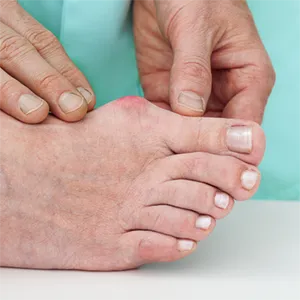What is a Bunion?
A bunion is a bone deformity caused by an enlargement of the joint at the base and side of the big toe (metatarsophalangeal joint). Bunions form when the toe moves out of place. The enlargement and its protuberance cause friction and pressure as they rub against footwear. Over time, the movement of the big toe angles in toward the other toes, sometimes overlapping a third toe (known as Hallux Valgus ). This causes more irritation or inflammation. In some cases, the big toe moves toward the second toe and rotates or twists ( Hallux Abducto Valgus . Bunions can also lead to other toe deformities, such as hammertoe.

Signs You May Have a Bunion
- Bulging growth on your big toe joint
- Pain or redness surrounding the bunion
- Big toe bent toward other toes
- Restricted motion of the big toe
- Pain while wearing shoes or doing normal activities
Discomfort from Bunions
Many people with bunions suffer from discomfort and pain from the constant irritation, rubbing, and friction of the bunion against shoes. The skin over the toe becomes red and tender. Because this joint flexes with every step, the bigger the bunion gets, the more it hurts to walk. Over time, bursitis or arthritis may set in, the skin on the bottom of the foot may thicken, and everyday walking may become difficult—all contributing to chronic pain.
What Causes Bunions?
Contrary to popular belief, bunions are not caused by wearing shoes that are too tight. While tight shoes can aggravate bunions, most bunions are formed due to a faulty foot structure that the patient was born with. Foot injuries, neuromuscular problems, flat feet, and pronated feet can also contribute to the formation of bunions.
Non-surgical Treatment of Bunions
If you have painful bunions but need to put off surgery, there are some non-surgical methods to help relieve the pressure and pain, and help reduce the progressive growth of the enlargement. These may include:
- Protective padding, often made from felt material, to eliminate the friction against shoes and help alleviate inflammation and skin problems.
- Removal of corns and calluses on the foot.
- Changing to carefully fitted footwear designed to accommodate the bunion and not contribute toward its growth.
- Orthotic devices—both over-the-counter and custom made—to help stabilize the joint and place the foot in the correct position for walking and standing.
- Exercises to maintain joint mobility and prevent stiffness or arthritis.
- Splints for nighttime wear to help the toes and joint align properly. This is often recommended for adolescents with bunions, because their bone development may still be adaptable.
Bunion Surgery
Depending on the size of the enlargement, misalignment of the toe, and pain experienced, conservative treatments may not be adequate to prevent progressive damage from bunions. In these cases, bunion surgery, known as a bunionectomy, may be advised to remove the bunion and realign the toe. The podiatrists at The Foot & Ankle Center are expert bunion surgeons, with decades of experience in bunion surgery. If you have painful bunions, come see us for a consultation.
New 3D Bunion Correction - Lapifuse® and Lapiplasty® Procedures
We offer Lapiplasty and Lapifuse bunion treatments, procedures that fix the root problem causing bunions, and get patients back on their feet much faster than the older, conventional bunion treatment. Learn More About New Bunion Treatments
Does it Hurt After Bunion Surgery?
The Foot & Ankle Center offers a unique and highly effective pain management protocol developed by Dr. Waskin for his bunion patients. We often hear from our patients how pleased they are to discover that the post-surgery pain was much less than they had imagined. We've found our pain management protocol to work very well for our patients in the years that we've been offering it. Dr. Waskin explains how it works in this video.
Learn More About Bunion Treatment in Richmond, Va.
The podiatrists at The Foot & Ankle Center have decades of experience treating bunions and orthopedic foot problems. Be sure to check out Dr. Waskin's Bunion Blog Posts . If you'd like to talk to one of our doctors about your bunions, please request a bunion consultation. Just give us a call or use the form below.
